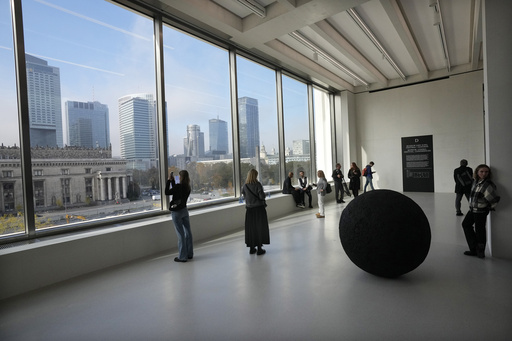
WARSAW, Poland — On Friday, Warsaw officially inaugurates its new modern art museum, a stunning creation by American architect Thomas Phifer. The museum’s design features a minimalist aesthetic filled with natural light, symbolizing the city’s commitment to openness and tolerance, as it distances itself from its communist past.
Located prominently on a busy street, the Museum of Modern Art in Warsaw is distinguished by its bright white exterior. Inside, visitors are greeted by a striking staircase that showcases geometric lines, leading to upper levels where expansive windows illuminate the gallery spaces.
City leaders and museum representatives emphasize that the museum’s design promotes conversation and community engagement, embodying the democratic values that Poland has embraced since overcoming authoritarian communist rule 35 years ago.
Warsaw’s Mayor, Rafa? Trzaskowski, described the museum’s opening as a significant milestone for the city, indicating that the ongoing project, which will eventually encompass a theater, aims to establish a vibrant new city center devoid of communist-era influences. He expressed optimism, stating, “This place will change beyond recognition; it will be a completely new center.” Trzaskowski pointed out that there hasn’t been a venue in Warsaw dedicated to showcasing Polish art in this way for decades.
After almost being entirely leveled by German forces during World War II, Warsaw was reconstructed, often in the dull architectural style favored by the region’s communist regimes. However, the post-communist period has witnessed a resurgence of economic growth, bringing forth modern glass structures, innovative museums, and the revitalization of historic sites.
The museum is built on a site that was previously a parking lot, positioned near the Palace of Culture and Science, an imposing skyscraper from the Stalinist era. While many residents have long resented this palace as a symbol of Soviet oppression, it has also become a defining feature of Warsaw’s skyline. In contrast, the museum’s bright and minimalistic design seeks to redefine the urban landscape.
“This location, directly across from the Palace of Culture and Science, is vital because it symbolizes a shift in the city’s center,” remarked museum director Joanna Mytkowska. She added that the museum is intended to foster an open and democratic culture.
A range of Western architects has been adding to Warsaw’s architectural landscape, which now includes Daniel Libeskind’s luxury tower and the Varso Tower, designed by Norman Foster, standing at 310 meters (1,017 feet), making it the tallest building in the European Union. Additionally, a Finnish team is behind the prominent Jewish history museum in the city.
Known for his work on significant projects throughout the United States, Phifer’s firm is associated with renowned installations like the North Carolina Museum of Art and the Corning Museum of Glass. When asked if he considers the Warsaw museum to be his masterpiece, the 71-year-old enthusiastically affirmed, “Of course.” He noted that from the outset of the project a decade ago, he recognized he was contributing to Warsaw’s impressive renaissance.
Financed by the city, the museum represents an investment of 700 million zloty (approximately $175 million). Although currently featuring only a handful of artpieces, it has the capacity to showcase around 2,500 works by prominent international artists. The full opening is slated for February, yet the initial programming, commencing Friday, will include various performances and events.
The surrounding area is still undergoing development, and plans include the creation of what Phifer refers to as a “forum space,” which will feature a garden and a theater with a distinctive black facade.
Despite the excitement surrounding the project, not everyone is fond of the museum’s starkness, with some locals likening it to a concrete bunker. Phifer remains confident that once visitors experience the interior, their perspective will shift, as the design enhances the art on display. “The museum can be described as a magic box. It has an element of mystery,” he explained, believing that the true essence of the space unfolds upon entry.
Mayor Trzaskowski acknowledged that ambitious architectural endeavors often provoke strong reactions. He referenced iconic projects like the Pompidou Centre in Paris and the Guggenheim in Bilbao, stating that genuine controversies are likely to arise once the avant-garde museum begins to host exhibitions.
